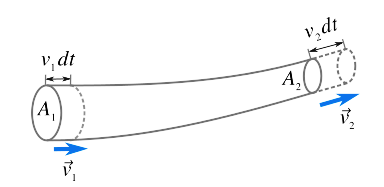
Water from a tap emerges vertically downwards with initial velocity ${{4 m/s}}$. The cross-sectional area of the tap is ${{A}}$. The flow is steady and pressure is constant through the water. The distance ${{h}}$vertically below the tap, where the cross-sectional area will becomes $\left( {\dfrac{{{2}}}{{{3}}}} \right){{A}}$ is: $\left( {{{g = 10 cm/}}{{{s}}^{{2}}}} \right)$.
Answer
219.9k+ views
Hint: First of all, write the equation of continuity i.e. and then substitute the given value in that equation. Then use Bernoulli’s theorem given as:${{\rho + \rho g}}{{{h}}_{{1}}}{{ + }}\dfrac{{{1}}}{{{2}}}{{\rho }}{{{v}}_{{1}}}^{{2}}{{ = \rho + \rho g}}{{{h}}_2}{{ + }}\dfrac{{{1}}}{{{2}}}{{\rho }}{{{v}}_2}^{{2}}$and then substitute the values in the formula and solve.
Complete step by step solution:
Equation of continuity

Let us consider a non-viscous, incompressible liquid which is flowing steadily through a pipe. Let ${{{A}}_{{1}}}$ be the cross-section, ${{{v}}_{{1}}}$ be the fluid velocity, ${{{\rho }}_{{1}}}$ be the fluid density at point ${{A}}$(left end of the pipe). And Let ${{{A}}_2}$ be the cross-section, ${{{v}}_2}$ be the fluid velocity, ${{{\rho }}_2}$ be the fluid density at point ${{B}}$(right end of the pipe).
The area of cross-sections are made such that.
Now, formula for mass is given by
And volume can be rewritten as ${{{A}}_{{1}}}{{ > }}{{{A}}_{{2}}}$ the product of area of cross section and length.
Thus, ${{m = \text{area of cross section} }} \times {{ length \times density}}$
Therefore, mass of fluid flowing through section A in small time dt is given by
${{{m}}_{{1}}}{{ = }}{{{a}}_{{1}}}{{ }}{{{v}}_{{1}}}{{ dt }}{{{\rho }}_{{1}}}$
Similarly, mass of fluid flowing through section B in small time dt is given by
${{{m}}_2}{{ = }}{{{a}}_2}{{ }}{{{v}}_2}{{ dt }}{{{\rho }}_2}$
By conservation of mass,
${{{m}}_{{1}}}{{ = }}{{{m}}_{{2}}}$
${{ }}{{{a}}_{{1}}}{{ }}{{{v}}_{{1}}}{{ dt }}{{{\rho }}_{{1}}} = {{ }}{{{a}}_2}{{ }}{{{v}}_2}{{ dt }}{{{\rho }}_2}$
As the fluid is incompressible, so ${{{\rho }}_{{1}}}{{ = }}{{{\rho }}_{{2}}}$
Hence ${{ }}{{{a}}_{{1}}}{{ }}{{{v}}_{{1}}} = {{ }}{{{a}}_2}{{ }}{{{v}}_2}$
On substituting values in above formula, we get
\[ {{ A \times 4 = }}\dfrac{{{2}}}{{{3}}}{{ A}}{{{v}}_{{2}}} \\
\Rightarrow {{ }}{{{v}}_{{1}}}{{ = 6 m/s}} \\
\]
Now using Bernoulli’s theorem
${{\rho + \rho g}}{{{h}}_{{1}}}{{ + }}\dfrac{{{1}}}{{{2}}}{{\rho }}{{{v}}_{{1}}}^{{2}}{{ = \rho + \rho g}}{{{h}}_2}{{ + }}\dfrac{{{1}}}{{{2}}}{{\rho }}{{{v}}_2}^{{2}}$
On further simplification, we get
$
{{g(}}{{{h}}_{{1}}}{{ - }}{{{h}}_{{2}}}{{) = }}\dfrac{{{1}}}{{{2}}}{{(}}{{{v}}_{{2}}}^{{2}}{{ - }}{{{v}}_{{1}}}^{{2}}{{)}} \\
\Rightarrow {{g(h) = }}\dfrac{{{1}}}{{{2}}}{{(}}{{{v}}_{{2}}}^{{2}}{{ - }}{{{v}}_{{1}}}^{{2}}{{)}} \\
$
On substituting values, we get
$
{{g(h) = }}\dfrac{{{1}}}{{{2}}}{{(}}{{{6}}^{{2}}}{{ - }}{{{4}}^{{2}}}{{)}} \\
\Rightarrow {{10 \times h = }}\dfrac{{{1}}}{{{2}}}{{(36 - 16)}} \\
\therefore {{h = 1 m}} \\
$
Thus, the value of h is ${{1 m}}$.
Note: Equation of continuity states that during streamlines flow of the non-viscous and incompressible fluid through pipes of varying cross-section, the product of area of cross-section and the normal fluid velocity remains constant throughout the flow.
Complete step by step solution:
Equation of continuity

Let us consider a non-viscous, incompressible liquid which is flowing steadily through a pipe. Let ${{{A}}_{{1}}}$ be the cross-section, ${{{v}}_{{1}}}$ be the fluid velocity, ${{{\rho }}_{{1}}}$ be the fluid density at point ${{A}}$(left end of the pipe). And Let ${{{A}}_2}$ be the cross-section, ${{{v}}_2}$ be the fluid velocity, ${{{\rho }}_2}$ be the fluid density at point ${{B}}$(right end of the pipe).
The area of cross-sections are made such that.
Now, formula for mass is given by
And volume can be rewritten as ${{{A}}_{{1}}}{{ > }}{{{A}}_{{2}}}$ the product of area of cross section and length.
Thus, ${{m = \text{area of cross section} }} \times {{ length \times density}}$
Therefore, mass of fluid flowing through section A in small time dt is given by
${{{m}}_{{1}}}{{ = }}{{{a}}_{{1}}}{{ }}{{{v}}_{{1}}}{{ dt }}{{{\rho }}_{{1}}}$
Similarly, mass of fluid flowing through section B in small time dt is given by
${{{m}}_2}{{ = }}{{{a}}_2}{{ }}{{{v}}_2}{{ dt }}{{{\rho }}_2}$
By conservation of mass,
${{{m}}_{{1}}}{{ = }}{{{m}}_{{2}}}$
${{ }}{{{a}}_{{1}}}{{ }}{{{v}}_{{1}}}{{ dt }}{{{\rho }}_{{1}}} = {{ }}{{{a}}_2}{{ }}{{{v}}_2}{{ dt }}{{{\rho }}_2}$
As the fluid is incompressible, so ${{{\rho }}_{{1}}}{{ = }}{{{\rho }}_{{2}}}$
Hence ${{ }}{{{a}}_{{1}}}{{ }}{{{v}}_{{1}}} = {{ }}{{{a}}_2}{{ }}{{{v}}_2}$
On substituting values in above formula, we get
\[ {{ A \times 4 = }}\dfrac{{{2}}}{{{3}}}{{ A}}{{{v}}_{{2}}} \\
\Rightarrow {{ }}{{{v}}_{{1}}}{{ = 6 m/s}} \\
\]
Now using Bernoulli’s theorem
${{\rho + \rho g}}{{{h}}_{{1}}}{{ + }}\dfrac{{{1}}}{{{2}}}{{\rho }}{{{v}}_{{1}}}^{{2}}{{ = \rho + \rho g}}{{{h}}_2}{{ + }}\dfrac{{{1}}}{{{2}}}{{\rho }}{{{v}}_2}^{{2}}$
On further simplification, we get
$
{{g(}}{{{h}}_{{1}}}{{ - }}{{{h}}_{{2}}}{{) = }}\dfrac{{{1}}}{{{2}}}{{(}}{{{v}}_{{2}}}^{{2}}{{ - }}{{{v}}_{{1}}}^{{2}}{{)}} \\
\Rightarrow {{g(h) = }}\dfrac{{{1}}}{{{2}}}{{(}}{{{v}}_{{2}}}^{{2}}{{ - }}{{{v}}_{{1}}}^{{2}}{{)}} \\
$
On substituting values, we get
$
{{g(h) = }}\dfrac{{{1}}}{{{2}}}{{(}}{{{6}}^{{2}}}{{ - }}{{{4}}^{{2}}}{{)}} \\
\Rightarrow {{10 \times h = }}\dfrac{{{1}}}{{{2}}}{{(36 - 16)}} \\
\therefore {{h = 1 m}} \\
$
Thus, the value of h is ${{1 m}}$.
Note: Equation of continuity states that during streamlines flow of the non-viscous and incompressible fluid through pipes of varying cross-section, the product of area of cross-section and the normal fluid velocity remains constant throughout the flow.
Recently Updated Pages
Electricity and Magnetism Explained: Key Concepts & Applications

JEE Energetics Important Concepts and Tips for Exam Preparation

JEE Isolation, Preparation and Properties of Non-metals Important Concepts and Tips for Exam Preparation

JEE Main 2021 July 25 Shift 1 Question Paper with Answer Key

JEE Main 2021 July 22 Shift 2 Question Paper with Answer Key

States of Matter Chapter For JEE Main Chemistry

Trending doubts
JEE Main 2026: Application Form Open, Exam Dates, Syllabus, Eligibility & Question Papers

Understanding Uniform Acceleration in Physics

Derivation of Equation of Trajectory Explained for Students

Hybridisation in Chemistry – Concept, Types & Applications

Understanding the Angle of Deviation in a Prism

Understanding Atomic Structure for Beginners

Other Pages
JEE Advanced Marks vs Ranks 2025: Understanding Category-wise Qualifying Marks and Previous Year Cut-offs

Units And Measurements Class 11 Physics Chapter 1 CBSE Notes - 2025-26

NCERT Solutions For Class 11 Physics Chapter 8 Mechanical Properties Of Solids

Motion in a Straight Line Class 11 Physics Chapter 2 CBSE Notes - 2025-26

NCERT Solutions for Class 11 Physics Chapter 7 Gravitation 2025-26

Mechanical Properties of Fluids Class 11 Physics Chapter 9 CBSE Notes - 2025-26




